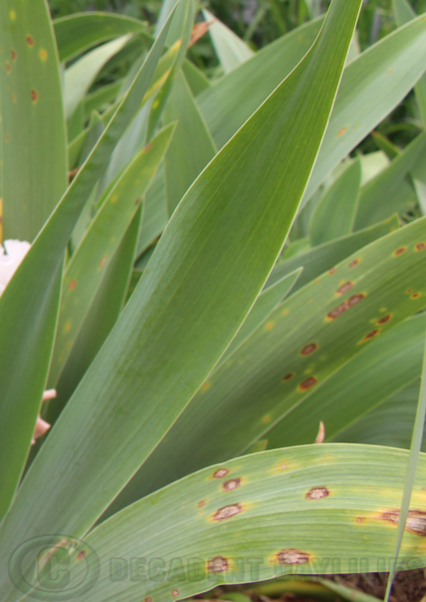Iris Leaf Spot on Bearded Iris
Leaf spot or blotch is one of the common and widespread diseases affecting Iris varieties and daylilies. Both bulbous and rhizome type Irises get affected by this fungal disease. Bearded Irises are often at great risk of the fungal infection. This disease is caused by the fungus Mycosphaerella Macrospora, earlier known as Didymellina Macrospora. Apart from Irises and daylilies, this fungus also attacks gladiolus, freesia, and narcissus. The fungus is also known as Cladosporium Iridis, Heterosporium Iridis, and Heterosporium Gracile. It is difficult to get rid of the fungus once the plant gets infected as the mycelium and spores can survive in plant debris. The fungus kills the plant slowly.
Description
The characteristic feature of the disease includes unsightly and annoying yellowish or brown spots or blotch on leaves. The spots will have a water-soaked border and slowly the spots get enlarged causing the leaves to dry. The disease reduces blooming and the leaves may become dead prematurely. The loss of leaves can weaken the bulbs or rhizomes of the plant and may result in the death of the plant. Damp weather conditions and overwatering can lead to this disease. The lesions can appear on both upper and lower surfaces of the leaf and it will die back starting from the tip.
Disease Cycle in Irises
Mycosphaerella Macrospora survives winter conditions as mycelium in older leaves and flower stems of the plant. Mycelium produces conidia when the weather is favourable or in spring or produces Ascospores in fruiting bodies called Perithecia. These spores can cause primary infections on plants during spring. In late spring and summer, the diseased spots will have masses of conidia, giving a grey or blackish appearance to the centre of leaf spots. Wind and splashing water can disseminate the spores to other parts of the same plant or other nearby irises. The spores germinate within hours in favourable temperatures of 10 to 25 degrees Celsius. The spores can enter the leaves through the epidermis or stomata.
How to Control the Iris Leaf Spot?
Here are the best methods to control or to prevent leaf spot disease in Irises.
- Plant Irises in well-draining soil where they receive full sun and have good air movement.
- Leave good space between plants and remove weeds to ensure proper air circulation.
- Avoid sprinkling water on foliage and avoid working among irises when the plants are wet to prevent the spreading of spores.
- Prevent overcrowding of clumps by dividing the clumps regularly.
- Keep the soil PH 6 or above by applying lime.
- Remove and destroy any infected leaves or flower stem as soon as they occur.
- Use disease-resistant varieties of Irises to plant in your garden.
- When mulching an Iris plant, leave at least 3 inches of space from the rhizome.
- Applying nitrogen foliar fertilisers can increase the resistance of the plant to this fungal disease.
If you feel that the infection is going to be severe, you can use fungicides to control leaf spot disease. Start spraying after the bearded iris winter dormant season early August. Spray the fungicide in 7 to 10-day intervals or as required protecting the new leaves.

